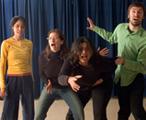Through the use of drama, therapists are able to encourage expression of personal narratives that are not exclusively verbal, but may also rely upon image, sound, movement, and gesture. Clients are relieved from the pressures of naturalism, as possibilities of being, thinking, feeling and relating may be explored through metaphor rather than realism. Performance is an ideal tool for dramatherapy due to its ability to portray life, while simultaneously retaining a distance from life. Performance provides a critical distancing from life: while performance can analyse living behaviour, it is also removed from everyday reality. This distancing protects the individual from being overwhelmed by experiences difficult to face. Framed through play, dramatherapy sessions can be a non-threatening way for clients to deepen their awareness of hidden aspects of the self.
Dramatherapy sessions invite clients to perform themselves in new ways. Individuals are assisted to untangle themselves from rigid ways of being, exploring and experimenting with different performances of the self. David Read-Johnson writes that his work is ‘attempting to dislodge the client from the highly bounded self perceptions he or she comes to the session with’.


An improvisational technique that is used in drama therapy, ‘transformations’, is taken from the theatre games of Viola Spolin. Transformation is like free associations through performance. Two performers begin a scene, becoming any character and performing any action that occurs to them. When a sound or movement within this scene reminds one player of something else, they transfom the scene simply by beginning to act as if they were in a new one. The other actor must accept this transformation and the scene continues until it shifts again.
Transformation in Action
In working with his client Elaine, Read Johnson discusses how this technique allows the client to discover why she overeats. In a therapy session Elaine becomes very upset. She calls for her mother and when she does not arrive, Elaine begins to overeat. Elaine performs herself gorging on food. Her shameful behaviour is acted out, and Elaine is encouraged to face what is usually suppressed. Elaine eats and eats until she grows into a huge giant. The therapist joins in, also performing a fat, and powerful character. These characters then stomp around the room, squishing little people. The therapist says: ‘Boy are you fat! I’ve never seen you looking so good’, to which Elaine answers, ‘Yeh, and aren’t you fat? God you look great!’ (p. 131). They go on to sing a song about being fat. Elaine discovers that her overeating is connected to a desire for comfort. She also transforms her feelings towards her body; rather than feeling uncomfortable with her weight, Elaine performs herself enjoying the power of her body. Dramatherapy may allow clients to discover and create new ways of being through a process of self-discovery. Through continual play and experimentation clients are invited to deepen their awareness of themselves.
